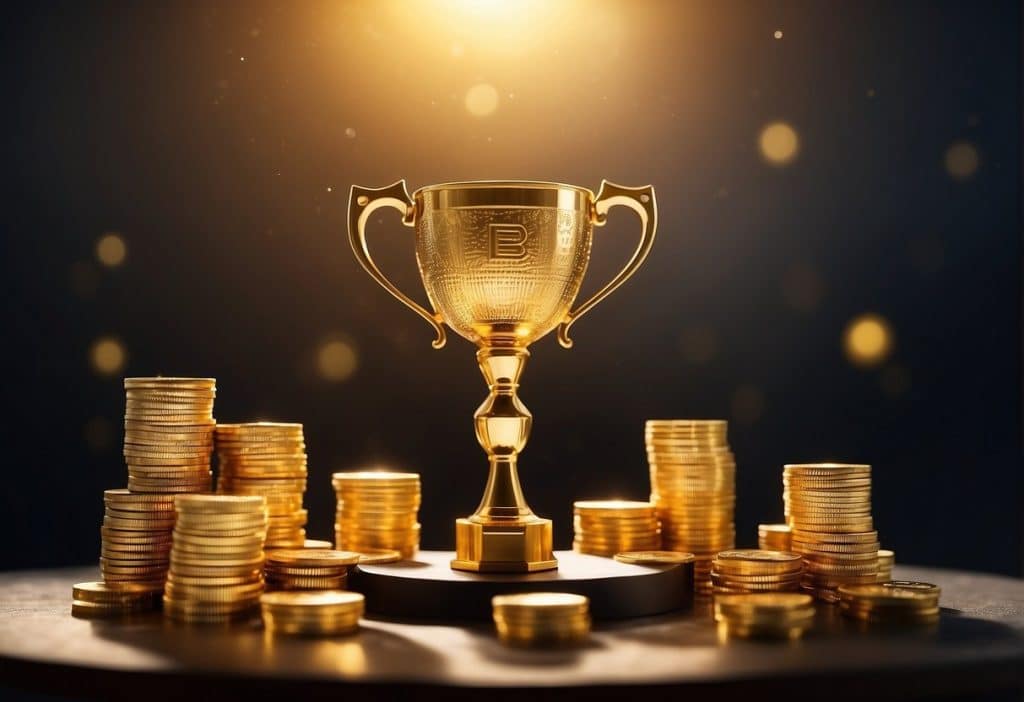Staking on Binance offers a strategic avenue for cryptocurrency holders to earn rewards on their holdings. When you engage in staking, you are essentially locking up your digital assets to support the operation and security of a blockchain network. In exchange for contributing to network stability and security, you receive staking rewards, often proportional to the amount and duration of your participation.

Binance, as a cryptocurrency exchange, simplifies the staking process by providing a platform where you can stake various cryptocurrencies without the need to directly interact with blockchain protocols. This ease of use affords both beginners and seasoned crypto enthusiasts the opportunity to earn passive income on their assets. The exchange also incorporates features that deal with technical aspects like private key management and trading stipulations to streamline user experience.
Key Takeaways
- Staking on Binance helps secure blockchain networks and earns you rewards.
- Binance’s platform allows for an effortless staking process for a variety of cryptocurrencies.
- Users benefit from a user-friendly interface and comprehensive support on the Binance staking platform.
NOT YET A BINANCE USER?
Join today with the Binance Referral Code for exclusive benefits or read our Binance Review to learn why Binance is the right exchange for you!
GET UP TO 50% OFF TRADING FEES WITH THE CODE “WUPBLUYN”
Understanding Staking
When you engage in staking, you’ll provide crucial support to a blockchain’s operation and security. Here’s a detailed look into the essentials of staking.
What is Staking?
Staking is the process of holding and locking a specific cryptocurrency to support a network and participate in transaction validation. This is common in Proof-of-Stake (PoS) blockchains where, by staking your coins, you’re contributing to the network’s overall trustworthiness and functionality.
Proof-of-Stake versus Proof-of-Work
Proof-of-Stake (PoS) and Proof-of-Work (PoW) are two fundamental consensus mechanisms used to verify transactions. In PoS, your staking increases your chance to validate transactions and earn rewards, while in PoW, transaction validation is done by miners solving complex puzzles, which requires significant amounts of energy.
| Proof-of-Stake | Proof-of-Work |
|---|---|
| Energy-efficient | High energy consumption |
| Based on staked amount | Based on computational power |
| Lower entry barrier | Requires specialized hardware |
The Role of Validators in Staking
As a validator, you are responsible for storing data, processing transactions, and adding new blocks to the blockchain. Your chance to be chosen to validate transactions correlates with the amount you have staked, making it both an opportunity for reward and a responsibility for maintaining network integrity.
Consensus Mechanism and Network Security
The consensus mechanism is what keeps the blockchain secure and decentralized. Staking involves participating in this very mechanism, where validators are selected to agree on the authenticity of transactions. If the consensus is reached, the changes are committed to the blockchain, strengthening its security and reliability.
Binance Staking Platform

Binance Staking provides a method for you to earn rewards by holding your cryptocurrency funds directly on the platform. This service simplifies the staking process, removing the need for technical knowledge or running a node on your part.
Binance as a Staking Hub
Binance stands out as a staking hub that enables you to receive monthly rewards and distributions. Staking on Binance is designed to be a hassle-free experience, with no need to set up nodes or fulfill minimum staking amounts and time lengths. The platform takes care of the technical side, allowing you to stake your cryptocurrencies and earn potential returns.
Supported Cryptocurrencies
Binance supports a variety of cryptocurrencies for staking, providing you with a range of options to grow your portfolio. Some of these include:
- ETH (Ethereum)
- BNB (Binance Coin)
- ADA (Cardano)
Each cryptocurrency comes with its own annual yield rates and terms.
Platform Features
The main features of the Binance Staking platform include:
- Monthly Rewards: Earn rewards on your holdings on a monthly basis.
- No Gas Fees: Binance deposits your funds into smart contracts without charging on-chain gas fees.
Furthermore, while Binance showcases projects and provides services to access and distribute earnings, it does not bear any liability for the performance of your staked assets.
Mobile App Accessibility
The Binance Staking service is accessible through Binance’s mobile app, available on both iOS and Android platforms. This allows you to manage your staking activities and track your rewards on the go, giving you constant control and monitoring capability over your staked assets.
The Staking Process

Staking on platforms like Binance involves locking up your cryptocurrency to support network operations and security, providing you with rewards over time.
How to Start Staking
To begin staking, you need to have an account with the staking service and possess a cryptocurrency that is eligible for staking. Here are the steps you typically follow:
- Log In: Access your account on the platform, such as Binance.US.
- Navigate: Find and tap the Staking section on the platform.
- Choose: Select the cryptocurrency you wish to stake.
- Follow Instructions: Carefully read any service-specific guidelines before confirming your staking action.
Staking Rewards
Staking rewards act as an incentive for participating in the ecosystem:
- Reward Rates: Vary by cryptocurrency, up to 12.50% in some cases.
- Frequency: Rewards can be distributed daily, weekly, or monthly, depending on the platform’s policy.
- Factors: The size of your stake and the staking duration can affect the rewards you earn.
Unstaking Process
When you decide to unstake your cryptocurrency, there are several factors to consider:
- Bonding & Unbonding Periods: There may be predefined periods before your funds become available.
- Processing Time: Withdrawals can take up to a day to be processed after you initiate an unstake request.
- Security: Platforms ensure the safety of your funds during the unstaking process.
By understanding these elements, you’ll be equipped to use staking services effectively and leverage them to earn rewards on your cryptocurrency holdings while contributing to the robustness of blockchain networks.
Staking Assets
In the context of Binance, staking assets refers to the process of locking up your cryptocurrencies to support the operations of a blockchain network, earning you rewards in return. It’s an investment strategy that can help you grow your holdings.
Types of Assets for Staking
On Binance.US, you have a variety of assets that you can stake. Some of the supported cryptocurrencies include:
- BNB (Binance Coin)
- ADA (Cardano)
- MATIC (Polygon)
- VET (VeChain)
- SOL (Solana)
- ATOM (Cosmos)
- ONE (Harmony)
- DOT (Polkadot)
Each of these assets has its own staking rewards, which are essentially the interest you earn on your investment.
Risk and Returns on Assets
The returns on staked assets come in the form of staking rewards, expressed as a percentage. For instance:
- Stake ADA for a 3.00% reward
- Stake VET for a 6.30% reward
- Stake SOL for an 11.20% reward
- Stake ONE for a 12.50% reward
While staking can be lucrative, it’s important for you to be aware of the risk involved. Your staked investments are locked for a period of time, during which their value can fluctuate depending on market conditions.
Ethereum Staking
With Ethereum’s transition to a Proof-of-Stake (PoS) consensus mechanism in 2022, ETH staking has become an integral part. By staking ETH, you’re contributing to the network’s security and efficiency. Binance simplifies this process by handling the technical aspects, such as depositing funds into the required smart contracts. This shift to PoS is significant for Ethereum in terms of its potential for increased speed and scalability.
Rewards and Earnings

In the realm of Binance Staking, your proficiency in optimizing earnings hinges on a clear comprehension of reward rates, harnessing the power of compounding interest, and understanding the mechanics of reward distribution.
Understanding Rewards Rates
Your staking rewards on Binance.US vary depending on the cryptocurrency you choose to stake. Precise rates change according to market conditions, but they can be as high as 12.50% for specific assets. Here’s a quick overview of the current reward rates for some popular cryptocurrencies:
- Ethereum (ETH): 3.30%
- Binance Coin (BNB): 1.70%
- Cardano (ADA): 2.00%
These rates are indicative of the returns you can expect for supporting network activities through staking.
Compounding Interest
Interest on your staked assets has the potential to compound over time, depending on the structure of the staking product. Compounding is when your staking rewards are reinvested to generate additional earnings. The exact nature of compounding can depend on whether the rewards are automatically restaked or if you need to do it manually.
Reward Distribution
Binance.US generally distributes staking rewards daily, though the exact frequency can depend on the cryptocurrency in question. To manage your staking assets and see your accumulated rewards:
- Visit the Staking Dashboard.
- Look for the Staked Balances section to find detailed information on your assets.
Staying informed about the timing and method of rewards distribution will help you strategize and maximize your staking benefits.
Security and Risks

When participating in Binance Staking, it is crucial to be aware of the security protocols in place and the potential risks you face. Protecting your digital assets and understanding the staking environment will help you navigate this space more effectively.
Digital Asset Security
Your digital assets are subject to various security threats during staking. Binance employs several layers of security measures to safeguard your funds, such as two-factor authentication (2FA) and cold storage for funds not actively traded. Despite these protections, you must remain vigilant as phishing attacks, unauthorized access, and security breaches can still occur.
Risk Factors in Staking
Staking on Binance involves several risk factors that could affect your returns:
- Slashing: Validators that fail to comply with network protocols may have their staked tokens or rewards reduced.
- Price Fluctuations: The value of your staked assets can fluctuate, impacting returns when accounting for market volatility.
- Market Risk: Broad market movements can affect the entire cryptocurrency ecosystem and subsequently the value of staked assets.
Understanding these risks helps in making informed decisions while engaging in staking activities.
Mitigation Strategies
To minimize exposure to staking risks on Binance, you can adopt the following strategies:
- Diversify your portfolio to avoid overexposure to any single cryptocurrency or staking pool.
- Regularly review and understand the terms of staking agreements, including penalties and time locks.
- Stay informed on market trends to anticipate and react to price fluctuations and market risk effectively.
Platform Support and Community
Binance Staking provides a robust support system and fosters an active community across various platforms. You will find diligent customer service, lively community engagement, and frequent updates on multiple social media channels.
Customer Support
When you engage with the Binance Staking platform, you have access to detailed instructions and support articles to guide you through the staking process. Moreover, Binance offers a 24/7 customer support service to assist you with any potential issues or questions.
| Support Feature | Availability |
|---|---|
| Comprehensive Guides | Yes |
| 24/7 Customer Service | Yes |
| Help Center | Yes |
| Ticketing System | Yes |
Community Engagement
Your involvement in Binance Staking extends beyond transactions. Community engagement is encouraged through various initiatives and discussion forums. Binance fosters a collaborative community where you can share experiences and best practices.
- Telegram: Join the conversation with fellow stakers.
- Binance Community: Engage in the official forums and discussions.
Social Media Channels
Stay updated and connect with the Binance community through their official social media outlets. You can follow them for the latest updates, educational content, and community feedback.
- Twitter: Get real-time updates and news.
- Facebook: Connect with the Binance community.
- Instagram: Explore visual content and stories related to Binance Staking.
| Social Media Platform | Purpose |
|---|---|
| Updates and Announcements | |
| Community Interaction & Support | |
| Visual Engagement and Information |
Make sure to follow these channels for official announcements and to stay in the loop with any platform-specific updates or changes.
Technical Considerations
When you decide to participate in Binance staking, understanding the technical aspects is crucial. It ensures you effectively support blockchain networks while optimizing your potential benefits.
Blockchain Networks and Staking
You engage with Proof-of-Stake (PoS) systems when staking on blockchain networks. Unlike the Proof-of-Work (PoW) system which Ethereum used before 2022, PoS allows you to lock your cryptocurrencies to support network security and operations. This participation is vital in validating transactions and forging new blocks in the blockchain network.
Staking Mechanisms
Staking mechanisms can vary, but they generally involve you locking your cryptocurrencies in the network. The primary purpose is to ensure the network’s integrity. In return for your support, you might receive staking rewards. Factors like network rules, the amount staked, and the staking duration can affect these rewards.
- Network Rules: Specific requirements set by blockchain protocols.
- Amount Staked: The quantity of cryptocurrency you lock.
- Staking Duration: How long you decide to stake your assets.
Smart Contracts and DeFi
Staking through DeFi involves smart contracts, which automate transactions without intermediaries. You should ensure the smart contracts you interact with are secure and audited, as they handle the transfer and locking of your cryptocurrencies within the staking mechanism. Smart contracts play a central role in the operation of DeFi platforms by enabling complex financial transactions on the blockchain.
Wallets and Storage
When engaging with Binance Staking, your choice of wallet plays a critical role in both participating in staking and ensuring the security of your assets. This section will guide you through the different types of wallets available for staking, the benefits of cold storage solutions, and the importance of wallet security.
Types of Wallets for Staking
- Custodial Wallets: These are wallets where the private keys are held by the service provider, such as Binance. When you stake on Binance.US, your funds are in a custodial wallet managed by the platform.
- Non-Custodial Wallets: You retain control of your private keys, which are never shared with a third-party. For staking, this option allows you more freedom but requires a greater understanding of blockchain technology and security.
Cold Storage Solutions
- Hardware Wallets: A form of cold wallets where your private keys are stored in an offline device. These are often considered the most secure type of wallet because they remain disconnected from the internet, reducing the avenues for potential hacks.
- Paper Wallets: Physical documents containing your private key information. While not as common for staking, they are a type of offline cold storage wallet option for holding your funds securely.
Wallet Security
- Encryption: Use strong passwords and encryption methods to protect your wallet. Strong encryption reduces the risk of unauthorized access.
- Two-Factor Authentication (2FA): Always enable 2FA where available, especially when using a custodial service for staking on Binance. It adds an extra layer of security to your account.
Remember that no matter where you choose to stake your cryptocurrency, security should be your top priority. By using secure wallets and following recommended security practices, you can ensure the safety of your assets while taking part in Binance Staking.
Terms and Conditions

When engaging with Binance Staking services, you are bound by specific Terms and Conditions that govern your participation and outline the mutual agreement between you and the service provider.
Staking Terms of Use
You must acknowledge and accept the Staking Terms of Use before participating in Binance ETH Staking. These terms cover key aspects such as:
- Eligibility: You need to ensure that you are eligible to participate according to the platform’s criteria.
- Risks: Understand that staking involves certain risks, and you should be aware of them before locking your assets.
- Rewards: The reward structure, including the rate and distribution timing, is outlined, and you must agree to these specifics.
Service Agreements
The Service Agreements detail the contractual relationship between you and Binance during your use of their staking services. Crucial points include:
- Service Usage: Guidelines on how to use the staking services are provided, which you must follow diligently.
- Compliance: You agree to comply with all relevant laws and regulations while using Binance’s staking services.
Your adherence to these terms ensures a transparent and fair staking experience for all involved parties.
Advanced Staking Concepts

Staking on platforms like Binance involves sophisticated mechanisms beyond merely locking up your digital assets. These concepts are crucial for you to understand to maximize your staking strategy and contribute to the blockchain’s function and governance.
Decentralized Governance
When you participate in staking, you take part in decentralized governance. You gain the ability to vote on important decisions that affect the blockchain’s future. Your influence is proportional to the amount of cryptocurrency you stake. It’s a critical component of the Proof-of-Stake (PoS) model, aligning your interests with the blockchain’s health and success.
Bonding and Unbonding Periods
Staking operates within specific timeframes known as bonding and unbonding periods.
- The bonding period is the time when your assets are locked in and cannot be transferred. It ensures the stability and security of the network. You must commit your tokens for this duration to support the network and earn rewards.
- Following this, the unbonding period is when your funds are in the process of being released back to you. During this time, they do not contribute to network security, nor do they earn rewards. Period Type Importance Bonding Period Securing the network, earning rewards Unbonding Period Assets are illiquid, no rewards
Validator Performance
Your staking rewards depend on the performance of the validator node that you delegate your stake to. A validator’s performance includes their uptime, the accuracy of their transaction validation, and how often they’re chosen to create new blocks. It’s in your best interest to choose a reliable validator, as their action or inaction directly impacts your staking returns.
- Uptime: The time a validator is actively online and participating in consensus.
- Transaction Validation: The accuracy with which a validator verifies transactions.
- Block Creation: The frequency at which a validator is selected to create new blocks.
Selecting a high-performing validator enhances your potential returns and contributes to a more robust blockchain network.
Frequently Asked Questions
In this section, you’ll find concise answers to common queries about staking on Binance, making it easier for you to navigate and maximize your staking experience.
How can I calculate my staking rewards on Binance?
To estimate your staking rewards on Binance, use the staking calculator provided on their platform. Your rewards will depend on the staked amount and the specific staking interest rate for the cryptocurrency.
What are the current staking rates offered by Binance?
Binance offers various staking rates that can reach up to 12.50%. The rate varies by cryptocurrency and market conditions. Check the Binance Staking page for the latest rates.
What are the best strategies for short-term staking investments on Binance?
For short-term staking on Binance, consider flexible staking options which allow for withdrawal without long lock-up periods. Consistently monitor the market for optimal entry and exit points.
How do Binance Locked Staking terms work, and what benefits do they offer?
Binance Locked Staking locks your crypto for a set period, typically ranging from 7 to 90 days, offering higher interest rates compared to flexible staking. It’s designed to provide greater rewards for committing your assets for a longer term.
Why might staking not be available for certain users on Binance?
Staking may be unavailable if a user’s region is restricted, the minimum staking amount is not met, or if the cap for a particular staking product has been reached.
What are the potential returns from staking USDT and ETH on Binance?
Potential returns from staking USDT and ETH on Binance vary based on market conditions and the staking period selected. Rates are periodically updated, so check the latest staking products on the Binance platform for current rates.
